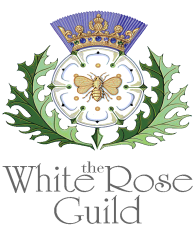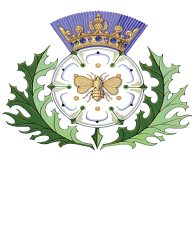Jacobite Glasses, beauty and symbolism.
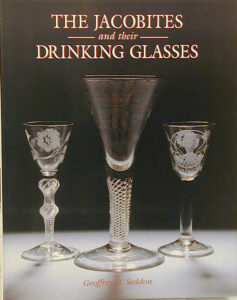 Jacobite glasses are engraved wine glasses used to honour Bonnie Prince Charlie, The Young Pretender and his father, James Francis Edward Stuart, The Old Pretender. They are far and away the most avidly sought after and perhaps best-known collectable of all Georgian wine glasses and Georgian drinking glasses.
Jacobite glasses are engraved wine glasses used to honour Bonnie Prince Charlie, The Young Pretender and his father, James Francis Edward Stuart, The Old Pretender. They are far and away the most avidly sought after and perhaps best-known collectable of all Georgian wine glasses and Georgian drinking glasses.
Jacobite means follower of James, that is James VIII of Scotland who became James III of England, he was the father of Bonny Prince Charlie. Charlie’s real name was Charles Edward Stuart and he lived in exile in France with his father.
The Stuarts wanted to reclaim the throne of Scotland and in 1745 Charles Edward Stuart came to Scotland and started the Jacobite Uprising to regain the British throne. The Uprising ended in defeat at the Battle of Culloden, 1746. The battle of Culloden was a terrible defeat with 1500-2000 killed on the battlefield and after Culloden the slaughter continued with the British government troops killing anyone who they thought was a supporter.
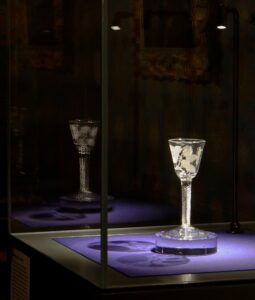 To protect themselves the Jacobites developed secret symbols, these symbols were so they could recognise each other, and also to keep their cause alive.
To protect themselves the Jacobites developed secret symbols, these symbols were so they could recognise each other, and also to keep their cause alive.
One symbol of the Jacobite glass was a flaw in the manufacturing of the glass and a small tear shape appeared, the Jacobites used this tear as a symbol for their sadness that a Stuart was not on the throne of Scotland.
The symbol of the Jacobites is a small white rose, more properly alba maxima and quite distinct from alba semi-plana which is the White Rose of York. Although opinions do vary, it is widely interpreted that the rose signifies James Francis Edward Stuart (The Old Pretender) or perhaps, more simply, the throne of England. It is a common symbol on many Jacobite glasses, often in conjunction with two buds, representing James’ sons. An open bud – generally to the left – alludes to his direct heir, Prince Charles Edward Stuart (Bonny Prince Charlie – The Young Pretender). A closed bud on the right represents Henry Benedict Stuart, Charles’ younger brother who renounced the throne and went into the Church.
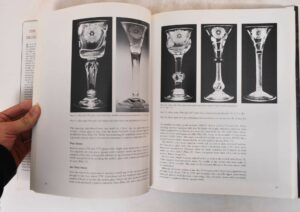 Other plants, insects and birds all appear on Jacobite glasses in abundance; bees signify undiminished loyalty to the royal lineage; moths, butterflies, dragonflies and beetles all pertain to fertility, rebirth and the perceived abundance of general wellbeing which would follow the hoped-for restoration of the crown; honeysuckle, carnations, pears, apples, vines are engraved, in addition to the rose, with increasingly oblique references in the most part to former head of the Stuart dynasty King Charles II; thistles signify the primacy of the Crown of Scotland in Jacobite fortunes.
Other plants, insects and birds all appear on Jacobite glasses in abundance; bees signify undiminished loyalty to the royal lineage; moths, butterflies, dragonflies and beetles all pertain to fertility, rebirth and the perceived abundance of general wellbeing which would follow the hoped-for restoration of the crown; honeysuckle, carnations, pears, apples, vines are engraved, in addition to the rose, with increasingly oblique references in the most part to former head of the Stuart dynasty King Charles II; thistles signify the primacy of the Crown of Scotland in Jacobite fortunes.
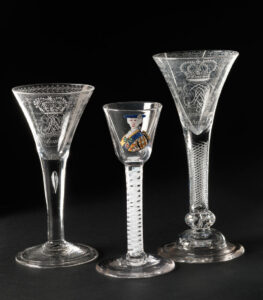 Almost as innumerable as these naturalistic icons on glassware of this ilk are Latin words and phrases – a very low-level of encryption for phrases intimating loyalty to the cause. Fiat (let it come to pass), Redeat (it returns), Reviriscit (it flourishes), Audentior Ibo (I go more boldly) and others all adorn glasses from which toasts to the enterprise would have been taken.
Almost as innumerable as these naturalistic icons on glassware of this ilk are Latin words and phrases – a very low-level of encryption for phrases intimating loyalty to the cause. Fiat (let it come to pass), Redeat (it returns), Reviriscit (it flourishes), Audentior Ibo (I go more boldly) and others all adorn glasses from which toasts to the enterprise would have been taken.
As the Jacobites were in effect operating as a secret society, there were many signs and symbols used so they could show their allegiance. One of these was that after dinner there was always the traditional toast to the King, if you were a Jacobite you were always careful to hold your wine glass over a fingerbowl of water which would indicate that you were toasting your glass to the King not of this country but to the King over the water in France.
Secret symbolism was also in the Jacobite drinking toast, the Scottish Gaelic toast ‘Slàinte Mhath!’ (pronounced Slanj-a-va) means great health, the Jacobite toast ‘Slàinte mhòr!”great health” the alternative meaning of “health to Marion”, Marion (Mòr) being a Jacobite code name for Prince Charles Edward Stuart
